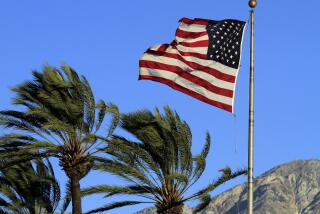They Call the Wind Isabel
- Share via
For the Los Angeles area, hurricanes like Isabel are like snowstorms and the National Football League. You can watch if you want, but there’s no need to care. Does it matter here if Atlanta beats Carolina, or Isabel does?
Sure, we’ve got occasional earthquakes in California. But you don’t have to watch them coming for days at a time with whirling color maps, evacuations, speculations on incoming devastation and ubiquitous pictures of people nailing plywood over picture windows. If a hurricane ever did blast through Los Angeles, the famous local sun and infamous UV rays would be obscured for hours by clouds of roof tiles en route to Nevada.
Here’s some useful advice on hurricanes for people who must live without them: If one ever shows up, reschedule the beach trip or sit way up the hill, for high tides can be 18 feet higher. Hold off on purchasing stock in insurance companies. Do buy shares of plywood companies.
Just as tornadoes seem to like the open spaces and trailer parks of Oklahoma and Arkansas, hurricanes (and typhoons if you’re in Asia) love tropics. Basically, a hurricane is a gang of thunderstorms on steroids, an intense organized system of XL updrafts and deluges up to 500 miles across and 8 miles tall.
On average, 10 tropical storms emerge over the Caribbean and Atlantic yearly. Six become hurricanes and one or two a year hit the U.S. mainland.
Contrary to popular belief, hurricanes’ role in nature is not to boost TV news ratings but to transfer heat from the equator toward the poles, like an atmospheric blender. Equatorial waters of 82 degrees or more heat air, which rises, carrying moisture up an invisible chimney, drawing in more air and warm water faster and faster. Hurricanes are areas of low air pressure that do not like dominant high-pressure areas, which explains why few hurricanes spawn in Washington, D.C. Skirting a North Atlantic high-pressure zone each autumn, hurricanes aim for the United States and the Caribbean.
Cooler water saps hurricanes’ energy, one reason Isabel weakened by a third recently. But recall, two-thirds of 155 miles an hour is still a significant bluster; think of wearing a baseball cap in a convertible’s backseat at 100 mph. Hurricanes can cause major damage -- ample rubble piles, roofless houses and upside-down cars.
Juan and Kate will be the next two tropical storms this year, followed by Larry. Next year’s will begin with Alex and Bonnie. But we’ll need seven to reach Gaston, the next forecast opportunity to hit the French, and 15 to slam the Germans (Otto).


